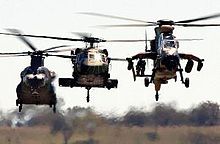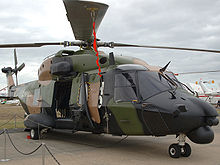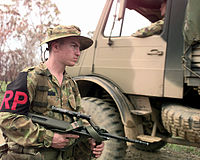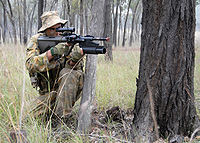- Weaponry of the Australian Army
-
Contents
Armoured vehicles
 M1A1 Abrams - 59 M1A1 Abrams and five M88 Hercules were purchased to replace the Leopard AS1 in service with the 1st Armoured Regiment. The first M1 equipped sub-units of the regiment became operational in mid-2007. The Abrams is the most powerful vehicle in the Australian inventory. While retaining the gas turbine engines, the Australian Abrams tanks use diesel fuel instead of the kerosene based JP-8 that powers American Abrams tanks.
M1A1 Abrams - 59 M1A1 Abrams and five M88 Hercules were purchased to replace the Leopard AS1 in service with the 1st Armoured Regiment. The first M1 equipped sub-units of the regiment became operational in mid-2007. The Abrams is the most powerful vehicle in the Australian inventory. While retaining the gas turbine engines, the Australian Abrams tanks use diesel fuel instead of the kerosene based JP-8 that powers American Abrams tanks. M113 - The Army has 700 M113 vehicles, which are used in the armoured reconnaissance and armoured personnel carrier roles, primarily by the Army's two mechanised infantry battalions. 431 of these will eventually be upgraded to M113AS3/4 standard.
M113 - The Army has 700 M113 vehicles, which are used in the armoured reconnaissance and armoured personnel carrier roles, primarily by the Army's two mechanised infantry battalions. 431 of these will eventually be upgraded to M113AS3/4 standard. /
/  ASLAV - The Army operates 255 ASLAV-25 vehicles, in a variety of roles including formation reconnaissance, as an infantry fighting vehicle, armoured ambulance or recovery vehicle.
ASLAV - The Army operates 255 ASLAV-25 vehicles, in a variety of roles including formation reconnaissance, as an infantry fighting vehicle, armoured ambulance or recovery vehicle. Bushmaster PMV - The Army has ordered over 837 Bushmaster vehicles, with deliveries commencing in mid-2005. Bushmasters primarily equip the motorised 7th Brigade, however B Squadron, 3/4 Cavalry Regiment also operate the lightly armoured vehicles in support of the 3rd Brigade.[1]
Bushmaster PMV - The Army has ordered over 837 Bushmaster vehicles, with deliveries commencing in mid-2005. Bushmasters primarily equip the motorised 7th Brigade, however B Squadron, 3/4 Cavalry Regiment also operate the lightly armoured vehicles in support of the 3rd Brigade.[1]
Artillery
 M777 howitzer - Thirty-five 155 mm M777s have been ordered as part of the first phase of the Land 17 project to replace the Army's inventory of towed artillery, with initial deliveries beginning in late 2010.[2]
M777 howitzer - Thirty-five 155 mm M777s have been ordered as part of the first phase of the Land 17 project to replace the Army's inventory of towed artillery, with initial deliveries beginning in late 2010.[2] M198 howitzer - The 155 mm M198 is the Army's main large artillery piece.
M198 howitzer - The 155 mm M198 is the Army's main large artillery piece. L118 Field Gun - The 105 mm field gun is the Army's primary artillery support weapon.
L118 Field Gun - The 105 mm field gun is the Army's primary artillery support weapon. M2A2 howitzer - The 105mm M2A2 is used by most Army Reserve artillery units.
M2A2 howitzer - The 105mm M2A2 is used by most Army Reserve artillery units. RBS-70 - The RBS-70 is a man portable SAM system, and is set to be the only SAM system in the Australian Army upon retirement of Rapier system. More sophisticated Bolide missiles have now been purchased.
RBS-70 - The RBS-70 is a man portable SAM system, and is set to be the only SAM system in the Australian Army upon retirement of Rapier system. More sophisticated Bolide missiles have now been purchased.
Aircraft
 S-70A Blackhawk - The Sikorsky S-70-A9 Blackhawk is the Army's primary battlefield lift/utility helicopter. The helicopters were assembled by Hawker de Havilland.
S-70A Blackhawk - The Sikorsky S-70-A9 Blackhawk is the Army's primary battlefield lift/utility helicopter. The helicopters were assembled by Hawker de Havilland. CH-47 Chinook - The Army operates Chinooks in the heavy lift role.
CH-47 Chinook - The Army operates Chinooks in the heavy lift role. OH-58 Kiowa - The Kiowa is utilised in the reconnaissance and battlefield surveillance role. It is being replaced by the Tiger armed reconnaissance helicopter.
OH-58 Kiowa - The Kiowa is utilised in the reconnaissance and battlefield surveillance role. It is being replaced by the Tiger armed reconnaissance helicopter. /
/  ARH Tiger - 'Armed Reconnaissance Helicopter', modified and upgraded version of the Tiger HAP.
ARH Tiger - 'Armed Reconnaissance Helicopter', modified and upgraded version of the Tiger HAP. MRH-90 - Medium lift/utility helicopter set to replace the UH-1 Iroquois (withdrawn from service in 2008), and eventually the Blackhawks.
MRH-90 - Medium lift/utility helicopter set to replace the UH-1 Iroquois (withdrawn from service in 2008), and eventually the Blackhawks.
Infantry weapons
F88S-A1 Austeyr, shown fitted is:
- a standard issue carry handle/1.5x power sight,
- M203 grenade launcher
- and a AN/PEQ-2 night aiming device.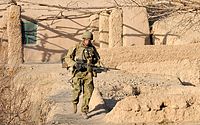 MAG-58 fitted with 3.4x Elcan Wildcat sight.
MAG-58 fitted with 3.4x Elcan Wildcat sight.
- Assault rifles and carbines
 /
/  F88 Austeyr - a derivative of the Austrian Steyr AUG STG-77 assault rifle. It is the ADF's standard individual weapon, which replaced the L1A1 SLR and the M16A1 rifle from front-line service in the late 1980s. The rifle is semi- or full-automatic and uses an Australian 5.56x45mm cartridge with a modified propellant. According to the ADF, the modified bullet is more accurate and goes further but costs more to make. The F88 Austeyr can use the 5.56x45mm NATO round but under continued use, damages the barrel. The rifle has a 508 mm barrel and an integral 1.5x magnified optical sight inside the carry handle. The weapon is manufactured under licence in Australia by Thales Australia (formerly Australian Defence Industries Ltd). Variants include:
F88 Austeyr - a derivative of the Austrian Steyr AUG STG-77 assault rifle. It is the ADF's standard individual weapon, which replaced the L1A1 SLR and the M16A1 rifle from front-line service in the late 1980s. The rifle is semi- or full-automatic and uses an Australian 5.56x45mm cartridge with a modified propellant. According to the ADF, the modified bullet is more accurate and goes further but costs more to make. The F88 Austeyr can use the 5.56x45mm NATO round but under continued use, damages the barrel. The rifle has a 508 mm barrel and an integral 1.5x magnified optical sight inside the carry handle. The weapon is manufactured under licence in Australia by Thales Australia (formerly Australian Defence Industries Ltd). Variants include:
- F88C Austeyr - carbine variant, fitted with a 407 mm barrel and is normally issued to personnel serving with space constraints and weight constraints (e.g. Cavalry, Light Horse and Paratroopers)
- F88S-A1 Austeyr - updated version that is issued to front-line combat infantry units. The rifle has the full length 508mm barrel and has a flat top receiver with a long MILSTD 1913 'Picatinny' rail to accommodate specialised optical devices and accessories.
- F88S-A1C Austeyr - updated 407 mm barreled carbine variant, with a MILSTD 1913 'Picatinny' rail.
- F88S-A2 Austeyr - an evolutionary upgrade of the current rifle to fulfill an operational capability gap. Deliveries of several thousand were completed in late-2009 to selected units for overseas service. Technical improvements in the F88SA2 include: a larger Picatinny Rail on top of the weapon, a modified sight housing, and a side rail mount for a torch and Night Aiming Devices (NAD). The colour of the weapon has also been changed to khaki to reduce the recognition signature.[3]
 M4A1 Carbine - used by various Australian special forces units. Its official designation in Australia is the M4A5.
M4A1 Carbine - used by various Australian special forces units. Its official designation in Australia is the M4A5.
- Precision rifles
 SR-98 - an Australian variant of the bolt action Accuracy International Arctic Warfare rifle, it is the standard-issue sniper rifle in the Australian Army and is chambered for 7.62x51mm. It replaced the Parker Hale Model 82 rifle in the late 1990s. Manufactured under licence in Australia by Thales Australia.
SR-98 - an Australian variant of the bolt action Accuracy International Arctic Warfare rifle, it is the standard-issue sniper rifle in the Australian Army and is chambered for 7.62x51mm. It replaced the Parker Hale Model 82 rifle in the late 1990s. Manufactured under licence in Australia by Thales Australia. SR-25 - a semi-automatic 7.62 x 51 mm sniper rifle. It has recently been observed in service with reconnaissance and special forces units of the Australian Army. It has seen service in Iraq, Afghanistan and East Timor.
SR-25 - a semi-automatic 7.62 x 51 mm sniper rifle. It has recently been observed in service with reconnaissance and special forces units of the Australian Army. It has seen service in Iraq, Afghanistan and East Timor. Mk 14 Enhanced Battle Rifle (M14EBR) - used by Australian special forces in Afghanistan.
Mk 14 Enhanced Battle Rifle (M14EBR) - used by Australian special forces in Afghanistan. Blaser 93 Tactical 2 - a straight-pull bolt action sniper rifle chambered in .338 Lapua Magnum. The rifle has been observed in service with special forces and infantry units in Afghanistan.
Blaser 93 Tactical 2 - a straight-pull bolt action sniper rifle chambered in .338 Lapua Magnum. The rifle has been observed in service with special forces and infantry units in Afghanistan. Heckler & Koch HK417 - the HK417 is being introduced to infantry and special forces units as the Marksman Rifle System to fill the gap between a sniper rifle and a 5.56mm derivative.[4]
Heckler & Koch HK417 - the HK417 is being introduced to infantry and special forces units as the Marksman Rifle System to fill the gap between a sniper rifle and a 5.56mm derivative.[4] AW50F - the AW50F is the largest-bore variant of the Arctic Warfare sniper rifles suited to the anti-materiel role. It is chambered for the .50 BMG cartridge, and is primarily used with Raufoss Mk211 HEIAP rounds. The AW50F was designed with an Australian-designed and manufactured barrel.
AW50F - the AW50F is the largest-bore variant of the Arctic Warfare sniper rifles suited to the anti-materiel role. It is chambered for the .50 BMG cartridge, and is primarily used with Raufoss Mk211 HEIAP rounds. The AW50F was designed with an Australian-designed and manufactured barrel.
- Machine guns
 F89 Minimi - the Army's standard light machine gun chambered for 5.56 × 45 mm NATO. The F89 is also manufactured under licence in Australia by Thales Australia.
F89 Minimi - the Army's standard light machine gun chambered for 5.56 × 45 mm NATO. The F89 is also manufactured under licence in Australia by Thales Australia. Maximi - the 7.62mm model of the Minimi is also in limited service.[5]
Maximi - the 7.62mm model of the Minimi is also in limited service.[5] FN MAG 58 - the Army's general purpose machine gun chambered for 7.62 × 51 mm NATO. It replaced the M60 machine gun.
FN MAG 58 - the Army's general purpose machine gun chambered for 7.62 × 51 mm NATO. It replaced the M60 machine gun. Browning M2HB-QCB - heavy machine gun not used at the infantry section level but rather as a heavy support weapon usually mounted on vehicles. It uses the .50 BMG cartridge and has an effective range in excess of 2,000 metres.
Browning M2HB-QCB - heavy machine gun not used at the infantry section level but rather as a heavy support weapon usually mounted on vehicles. It uses the .50 BMG cartridge and has an effective range in excess of 2,000 metres.
- Pistols
 Browning GP-35 Mk. III Hi-Power - self-loading pistol chambered for 9 x 19 mm NATO, is the standard-issue service pistol of the Australian Defence Force.
Browning GP-35 Mk. III Hi-Power - self-loading pistol chambered for 9 x 19 mm NATO, is the standard-issue service pistol of the Australian Defence Force. Heckler & Koch USP - used by various special forces units.
Heckler & Koch USP - used by various special forces units.
- Sub-machine guns and shotguns
 Heckler & Koch MP5 - a 9x19mm calibre sub-machine gun primarily used by special forces units.
Heckler & Koch MP5 - a 9x19mm calibre sub-machine gun primarily used by special forces units. Remington Model 870 - the Remington Model 870 is a 12 gauge pump-action shotgun. This firearm is commonly used by both Special Forces and Military Police personnel.
Remington Model 870 - the Remington Model 870 is a 12 gauge pump-action shotgun. This firearm is commonly used by both Special Forces and Military Police personnel.
- Grenade launchers
 M203 grenade launcher - 40x46mm grenade launcher attached to the F88 (RM Equipment M203PI) and M4 (Colt M203-A1) rifles. It replaced the M79 "Wombat Gun".
M203 grenade launcher - 40x46mm grenade launcher attached to the F88 (RM Equipment M203PI) and M4 (Colt M203-A1) rifles. It replaced the M79 "Wombat Gun". Mk 19 AGL - automatic grenade launcher that fires 40x53mm grenades at a cyclic rate of 325-375 rounds per minute, giving a practical rate of fire of 60 rounds per minute (rapid) and 40 rounds per minute (sustained). Usually vehicle mounted by Australian special forces units.
Mk 19 AGL - automatic grenade launcher that fires 40x53mm grenades at a cyclic rate of 325-375 rounds per minute, giving a practical rate of fire of 60 rounds per minute (rapid) and 40 rounds per minute (sustained). Usually vehicle mounted by Australian special forces units.
- Anti-armour
 66 mm Short-Range Anti-Armour Weapon (M72 LAW) - a 66 mm single shot disposable anti-armour weapon.
66 mm Short-Range Anti-Armour Weapon (M72 LAW) - a 66 mm single shot disposable anti-armour weapon. L14A1 Carl Gustav Medium Direct Fire Support Weapon - the Saab Bofors Dynamics is a 84mm recoilless rifle primarily used in the anti-armour role.
L14A1 Carl Gustav Medium Direct Fire Support Weapon - the Saab Bofors Dynamics is a 84mm recoilless rifle primarily used in the anti-armour role. Javelin Anti-Tank Guided Missile (ATGM) - the Javelin is a long-range, guided anti-armour missile.
Javelin Anti-Tank Guided Missile (ATGM) - the Javelin is a long-range, guided anti-armour missile.
- Mortars
 F2 81mm Mortar - the 81 mm mortar is the Army's primary mortar system.
F2 81mm Mortar - the 81 mm mortar is the Army's primary mortar system.
- Miscellaneous
 M18A1 Claymore Antipersonnel Mine - the Claymore is a command-detonated anti-personnel fragmentation weapon. It is called an "Anti-Personnel Device" due to the Commonwealth of Australia agreeing not to use mines of any type.
M18A1 Claymore Antipersonnel Mine - the Claymore is a command-detonated anti-personnel fragmentation weapon. It is called an "Anti-Personnel Device" due to the Commonwealth of Australia agreeing not to use mines of any type. F1 fragmentation hand grenade - hand grenade with an effective killing radius of 6m. Manufactured by Thales Australia.
F1 fragmentation hand grenade - hand grenade with an effective killing radius of 6m. Manufactured by Thales Australia. M9 Bayonet - the Army's primary combat knife used by all personnel and attached on the M16 rifle, the F88 Austeyr and the M4 carbine.
M9 Bayonet - the Army's primary combat knife used by all personnel and attached on the M16 rifle, the F88 Austeyr and the M4 carbine.
Combat uniform of the Australian Army
There are three major combat uniforms worn by the Australian Defence Force, they are:
- Disruptive Pattern Combat Uniform - DPCU is the standard combat uniform worn in terrains that feature green and brown-shaded flora. The pattern has been in service since the late 1980s.
- Disruptive Pattern Desert Uniform - DPDU is the Desert Combat uniform worn by Australian Defence Force personnel in theatres where the terrain is arid. It uses the same pattern as DPCU, but with the colours changed to suit the desert terrain. This uniform was instituted in the early 2000s, to meet the need for personnel serving overseas in Southwest Asia
- MultiCam - in late 2010, the ADF announced that Multicam will be the standard pattern for all regular Australian Army personnel in Afghanistan after trials were conducted by special operations units. Multicam, it is said, provided "... troops with greater levels of concealment across the range of terrains in Afghanistan – urban, desert and green." Previously, depending upon the terrain, Australian troops had to alternate between green and desert colored DPCUs.[6][7] Furthermore, the Defence Material Organisation has since announced that they had obtained a licence from Crye Associates to locally produce Multicam and for a new uniquely Australian pattern to be developed by Crye to replace DPCU uniforms.[8]
The current issue of DPCU is known as 'DPCU-NIR' - or Disruptive Pattern Combat Uniform - Near Infra-Red. The Defence Science and Technology Organisation has developed materials for use in combat uniforms which will reduce night-vision detection, and it has been integrated into this uniform, which also sports a new cut and shape, the NATO-style front rank epaulette, zip-fastening, sleeve pockets and Velcro tabs.[9]
Future equipment
Infantry weapons
The Army had previously planned on replacing the F88 with the Advanced Individual Combat Weapon (AICW) by 2010–2012. The most notable feature of the AICW is a grenade launcher with 3 stacked rounds that uses electricity to fire off the grenade. The AICW aims to provide the infantry soldier with the ability to fire multiple grenades without having to reload, and to switch between 5.56 mm ballistic rounds and 40 mm grenades without changing sights, trigger or stance, giving the operator more versatility and reduced reaction times in combat.[citation needed] Regardless, the F88 is now likely to remain in service until about 2020, and selected units of the Australian Army are now re-equipping with the F88S-A2.[3]
Artillery
 Eurocopter Tiger in 2005.
Eurocopter Tiger in 2005.
The Land 17 project has been initiated to choose replacements for the army's 155mm and 105 mm artillery. Two batteries of 155mm self-propelled guns and four batteries of 155mm towed guns will be acquired for the regular army, while all mortars will be replaced with a new and more capable system. In October 2009 it was announced that the M777A2 155mm towed howitzer has been selected to fill the towed requirement.[10]
Aircraft
The Army is reorganising its aviation element, through the purchase of 22 Tiger attack helicopters and 30 MRH 90 utility helicopters (30 helicopters out of a total purchase of 46, which will be divided between Army, Fleet Air Arm and a joined MRH 90 training base). Furthermore, seven CH-47F Chinook heavy lift helicopters will be purchased to replace the Army's five remaining CH-47D Chinook helicopters. In addition, the Army will also acquire a number of UAVs (including a number of Boeing ScanEagles and 18 RQ-7 Shadow) which will equip the 20th Surveillance and Target Acquisition Regiment, currently forming at Enoggera Barracks, Queensland.[11]
References
- ^ "More vehicles on the way". Army News: The Soldiers' Newspaper (Canberra: Australian Department of Defence): p. 16. 26 May 2011. http://www.defence.gov.au/news/armynews.
- ^ Bergmann, Kym (23 October 2010). "Push is on to bring out the big guns". The Australian (News Ltd). http://www.theaustralian.com.au/national-affairs/defence/push-is-on-to-bring-out-the-big-guns/story-e6frg8yo-1225940262119. Retrieved 4 January 2011.
- ^ a b "Thales upgrades Austeyr rifle to meet ADF operational needs". Thales Australia. 29 October 2008. http://www.thalesgroup.com/Press_Releases/Australia_291008/. Retrieved 2009-09-23.
- ^ Juchniewicz, Nathan (21 July 2011). "New weapon to go the distance". Army News: The Soldiers' Newspaper (Canberra: Australian Department of Defence): p. 3. http://digital.realviewtechnologies.com/?xml=defencenews_army.xml. Retrieved 27 August 2011.
- ^ Juchniewicz N.; Manchip J. (12 May 2011). "Gun maximises combat power". Army News: The Soldiers' Newspaper (Canberra: Australian Department of Defence): p. 4. http://digital.realviewtechnologies.com/default.aspx?xml=defencenews_army.xml. Retrieved 14 May 2011.
- ^ New combat uniform makes troops job easier, Australian Department of Defence, 19 November 2010.
- ^ Land Warfare Conference - Minister for Defence Materiel, Australian Department of Defence, 19 November 2010.
- ^ New defence uniforms on the way, The Sydney Morning Herald, 30 May 2011
- ^ Cloak of invisibility. Army News 22 April 2004.
- ^ DMO. "LAND 17 Artillery Replacement". http://www.defence.gov.au/dmo/lsd/land17/index.cfm. Retrieved 2009-10-28.
- ^ "Army buys 18 Shadow UAVs". Australian Aviation. Phantom Media. 2 August 2010. http://australianaviation.com.au/2010/08/army-buys-18-shadow-uavs/. Retrieved 13 October 2011.
External links
- Manufacturing process of the F88 rifle - Army News, 6 September 2007.
 Australian Army
Australian ArmyComponents Equipment History Personnel Categories:- Weapons of Australia
- Military equipment of the Australian Army
Wikimedia Foundation. 2010.

